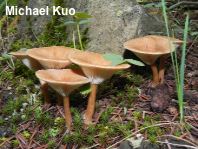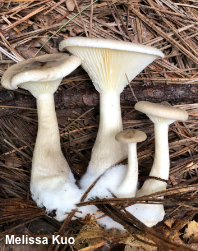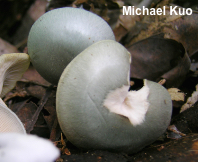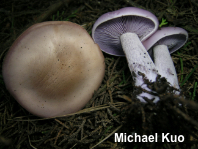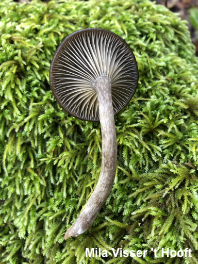| Major Groups > Gilled Mushrooms > Pale-Spored > Clitocyboid Mushrooms |

|
Clitocyboid Mushrooms [ Basidiomycota > Agaricales > Tricholomataceae . . . ] by Michael Kuo Traditionally, "Clitocybe" was a genus of gilled mushrooms that lacked partial veils and featured white, yellowish, or pinkish spore prints, as well as gills that were broadly attached to the stem or run down it. Some mycologists separated "Lepista," featuring clitocyboid mushrooms with spiny spores and pinkish spore prints, as a separate genus, while others viewed the lepistas as a section within the genus Clitocybe. Let's call all of these mushrooms "clitocyboid," at least for identification purposes, since they form an easily recognized group. However, if you noticed the quotation marks I placed around "Clitocybe" and you are now waiting for me to pull the taxonomic rug out from under your feet, I congratulate you on having a much better sense of punctuation than my freshmen, who appear to believe we should use "quote marks" for "anything" we "want" . . . and yes, the writing is on the wall: while a comprehensive DNA study of the mushrooms traditionally placed in Clitocybe and Lepista has not yet been done (to my knowledge), enough work has been done to determine that the mushrooms in question are not all closely related. Some clitocyboid mushrooms, in fact, are only distantly related, and a lot of things may have to be re-arranged—including the genus Collybia, which, it turns out, sits smack in the middle of Clitocybe and Lepista (neither of which, by the way, represents a coherent group of related species). There are several possible rearrangement strategies (see Alvarado et al. 2015 for a discussion), but all will depend on thorough analysis of many well-documented collections and the "lumping" or "splitting" preferences of the people doing the taxonomic work. For now, anyway, I will maintain a doomed Collybia and a large Clitocybe, and subsume Lepista. Identification of clitocyboid mushrooms, beyond a handful of easily recognized "field guide species," often depends on microscopic analysis—and Clitocybe literature for North America can be hard to work with for non-specialists. H. E. Bigelow's two-part monograph (1982, 1985) of the North American Species of Clitocybe can be found online for free. If you are in California, Denise Gregory's San Francisco State University masters thesis on Clitocybe in California is essential. Further clitocyboid mushroom literature is listed below. As far as pronouncing Clitocybe, make it rhyme with "I toss a bee." While my usual response to the question of how to "correctly" pronounce scientific names is, "Who cares?" (see this page for details), the case of Clitocybe may be an exception if you want to avoid the strange looks you will get from mushroom folks when you pronounce it as though it were an English word. It is one thing to be received as a bumpkin who doesn't know how to pronounce scientific names, but it is another thing entirely to be received as a perverted bumpkin who doesn't know how to pronounce scientific names. Also note that the late Gary Lincoff, when forced by his editors for the Audubon Society Field Guide to North American Mushrooms (1992) to create "common" names for our continent's mushrooms, used "trich" for species of Tricholoma ("soapy trich" for Tricholoma saponaceum, and so on) but did not employ a similar strategy for species of Clitocybe. Species Pages Ampulloclitocybe avellaneialba |
|
|
References Alvarado, P., G. Moreno, A. Vizzini, G. Consiglio, J. L. Manjón & L. Setti (2015). Atractosporocybe, Leucocybe and Rhizocybe: three new clitocyboid genera in the Tricholomatoid clade (Agaricales) with notes on Clitocybe and Lepista. Mycologia 107: 123–136. Alvarado, P., P. -A. Moreau, B. Dima, A. Vizzini, G. Consiglio, G. Moreno, L. Setti, T. Kekki, S. Huhtinen, K. Liimatainen & T. Niskanen (2018). Pseudoclitocybaceae fam. nov. (Agaricales, Tricholomatineae), a new arrangement at family, genus and species level. Fungal Diversity 90: 109–133. Ammirati, J. F., A. D. Parker & P. B. Matheny (2007). Cleistocybe, a new genus of Agaricales. Mycoscience 48: 282–289. Antonin, V., J. Borovicka, J. Holec, A. Piltaver & M. Kolarik (2019). Taxonomic update of Clitocybula sensu lato with a new generic classification. Fungal Biology 123: 431–447. Barrasa, J. M, F. Esteve-Raventos & R. M. Dahncke (2006). Clitocybula canariensis (Tricholomataceae), a new brown-rot fungus from the Canary Islands (Spain). Fungal Diversity 22: 1–11. Bigelow, H. E. & A. H. Smith (1969). The status of Lepista—A new section of Clitocybe. Brittonia 21: 144–177. Bigelow, H. E. & Smith, A. H. (1970). A new Clitocybe from Michigan. The Michigan Botanist 9: 30–33. Bigelow. H. E. & A. H. Smith (1973). Cantharocybe, a new genus of Agaricales. Mycologia 65: 485–488. Bigelow, H. E. (1973). The genus Clitocybula. Mycologia 65: 1101–1116. Bigelow, H. E., O. K. Miller, Jr. & H. D. Thiers (1976). A new species of Omphalotus. Mycotaxon 3: 363–372. Bigelow, H. E. (1977). A new Clitocybe from Texas. Mycologia 69: 1047–1049. Bigelow, H. E. (1977). New taxa of Clitocybe. Mycotaxon 6: 181–185. Bigelow, H. E. (1981). Spore ornamentation in the Tricholomataceae I. Mycologia 73: 128–140. Bigelow, H. E. (1982). Species described in Clitocybe by C. H. Peck and W. A. Murrill. Sydowia 35: 37–74. Bigelow, H. E. (1982a). North American species of Clitocybe. Part I. Germany: Cramer. 280 pp. Bigelow, H. E. (1982b). Species described in Clitocybe by C. H. Peck and W. A. Murrill. Sydowia 35: 37–74. Bigelow, H. E. (1983). Some clampless species of Clitocybe. Cryptogamie, Mycologie 4: 93–98. Bigelow, H. E. (1985). North American species of Clitocybe. Part II. Germany: Cramer. 191 pp. Christensen, M. & G. Gulden (2018). Lepista (Fr.) W. G. Sm. In Knudsen, H. & J. Vesterholt, eds. Funga Nordica: Agaricoid, boletoid, clavarioid, cyphelloid and gastroid genera. Copenhagen: Nordsvamp. 469–473. Cochran, K. W. & Cochran, M. W. (1978). Clitocybe clavipes: Antabuse-like reaction to alcohol. Mycologia 70: 1124–1126. Gregory, D. C. (2007). The genus Clitocybe of California. Masters thesis, San Francisco State University. Gregory, D. C. (2007). Key to the species of Clitocybe, Ampulloclitocybe, and Infundibulicybe from the genus Clitocybe of California. Retrieved from the MykoWeb Web site: http://mykoweb.com/CAF/keys/Clitocybe_key.pdf Gulden, G. (1983). Studies in Lepista (Fr.) W. G. Smith section Lepista (Basidiomycotina, Agaricales). Sydowia 36: 59–74. Harmaja, H. (1969). The genus Clitocybe (Agaricales) in Fennoscandia. Karstenia 10: 5–121. Harmaja, H. (1970). Type studies on Agaricales described as Clitocybe and Omphalina. Karstenia 11: 35–40. Harmaja, H. (1974). Singerella n. gen., a separate genus for Clitocybe hydrogramma. Karstenia 14: 113–115. Harmaja, H. (1974). Pseudoclitocybe atra (Vel.) n. comb. Karstenia 14: 126–128. Harmaja, H. (1974). Three new taxa of Lepista: L. fasciculata n. sp., L. singeri n. sp., and Lepista subgenus Laevispora n. subg. Karstenia 14: 129–132. Harmaja, H. (1976). A further revision of the generic limit between Lepista and Clitocybe. Karstenia 15: 13–15. Harmaja, H. (1976). Type studies in Clitocybe. 2. Karstenia 15: 16–18. Harmaja, H. (1978). New species and new combinations in the pale-spored Agaricales. Karstenia 18: 29–30. Harmaja, H. (1979). Type studies in Clitocybe. 3. Karstenia 19: 22–24. Harmaja, H. (1979). Type studies in Clitocybe 4. Karstenia 19: 50–51. Harmaja, H. (2003). Notes on Clitocybe s. lato (Agaricales). Annales Botanici Fennici 40: 213–218. Kauffman, C. H. 1927. The genus Clitocybe in the United States, with a critical study of all the north temperate species. Papers of the Michigan Academy of Science, Arts, and Letters 8: 153–214. Kirchmair, M., R. Pöder, C. G. Huber & O. K. Miller, Jr. (2002). Chemotaxonomical and morphological observations in the genus Omphalotus (Omphalotaceae). Persoonia 17: 583–600. Kirchmair, M. & R. Pöder (2002). Why Omphalotus illudens (Schwein.) Bresinsky et Besl is an independent species. Revista Catalana de Micologia 24: 215–223. Kirchmair, M., S. Morandell, D. Stolz, R. Pöder & C. Sturmbauer (2004). Phylogeny of the genus Omphalotus based on nuclear ribosomal DNA-sequences. Mycologia 96: 1253–1260. Kuyper, T. W. (1995). Clitocybe. In Bas, C., Th. W. Kuyper, M. E. Noordeloos & E. C. Vellinga. Flora Agaricina Neerlandica. Vol. 3. Netherlands: A. A. Balkema. 42–62. Kuyper, T. W. (1995). Lepista. In Bas, C., Th. W. Kuyper, M. E. Noordeloos & E. C. Vellinga. Flora Agaricina Neerlandica. Vol. 3. Netherlands: A. A. Balkema. 67–75. Laursen, G. A., O. K. Miller, Jr. & H. E. Bigelow (1976). A new Clitocybe from the Alaskan arctic. Canadian Journal of Botany 54: 976–980. Murrill, W. A. (1915). The genus Clitocybe in North America. Mycologia 7: 256–283. Noordeloos, M. E. & T. W. Kuyper (1995). Lepista. In In Bas, C., Th. W. Kuyper, M. E. Noordeloos & E. C. Vellinga. Flora Agaricina Neerlandica. Vol. 3. Netherlands: A. A. Balkema. 67–75. Petersen, R. H. & K. W. Hughes (1998). Mating systems in Omphalotus (Paxillaceae, Agaricales). Plant Systematics and Evolution 211: 217–229. Redhead, S. A., J.-M. Moncalvo, R. Vilgalys & F. Lutzoni (2002). Phylogeny of agarics: Partial systematics solutions for bryophilous omphalinoid agarics outside of the Agaricales (Euagarics). Mycotaxon 82: 151–168. Redhead, S. A., F. Lutzoni, J.-M. Moncalvo & R. Vilgalys (2002). Phylogeny of Agarics: Partial systematics solutions for core omphalinoid genera in the Agaricales (Euagarics). Mycotaxon 83: 19–57. Singer, R. (1979). Keys for the identification of the species of Agaricales II. Sydowia 31: 193–237. Stott, K., C. Desmerger & P. Holford (2005). Relationship among Lepista species determined by CAPS and RAPD. Mycological Research 109: 205–211. Trappe, J. M. (1972). Parasitism of Helvella lacunosa by Clitocybe sclerotoidea. Mycologia 64: 1337–1340. Vesterholt, J. (2018). Clitocybe (Fr.) Staude. In Knudsen, H. & J. Vesterholt, eds. Funga Nordica: Agaricoid, boletoid, clavarioid, cyphelloid and gastroid genera. Copenhagen: Nordsvamp. 451–462. Vesterholt, J. (2018). Infundibulicybe Harmaja. In Knudsen, H. & J. Vesterholt, eds. Funga Nordica: Agaricoid, boletoid, clavarioid, cyphelloid and gastroid genera. Copenhagen: Nordsvamp. 467–469. Vizzini, A., M. Contu, E. Musumeci & E. Ercole (2011). A new taxon in the Infundulicybe gibba complex (Basidiomycota, Agaricales, Tricholomataceae) from Sardinia (Italy). Mycologia 103: 203–208. Vizzini, A. & E. Ercole (2012). Paralepistopsis gen. nov. and Paralepista (Basidiomycota, Agaricales). Mycotaxon 120: 253–267. Voitk, A., I. Saar, R. Lebeuf & P. Kennedy (2020). The Pseudoomphalina kalchbrenneri complex in North America. Botany 98: 91–101. This site contains no information about the edibility or toxicity of mushrooms. Cite this page as: Kuo, M. (2021, September). Clitocyboid mushrooms. Retrieved from the MushroomExpert.Com Web site: http://www.mushroomexpert.com/clitocyboid.html © MushroomExpert.Com |
